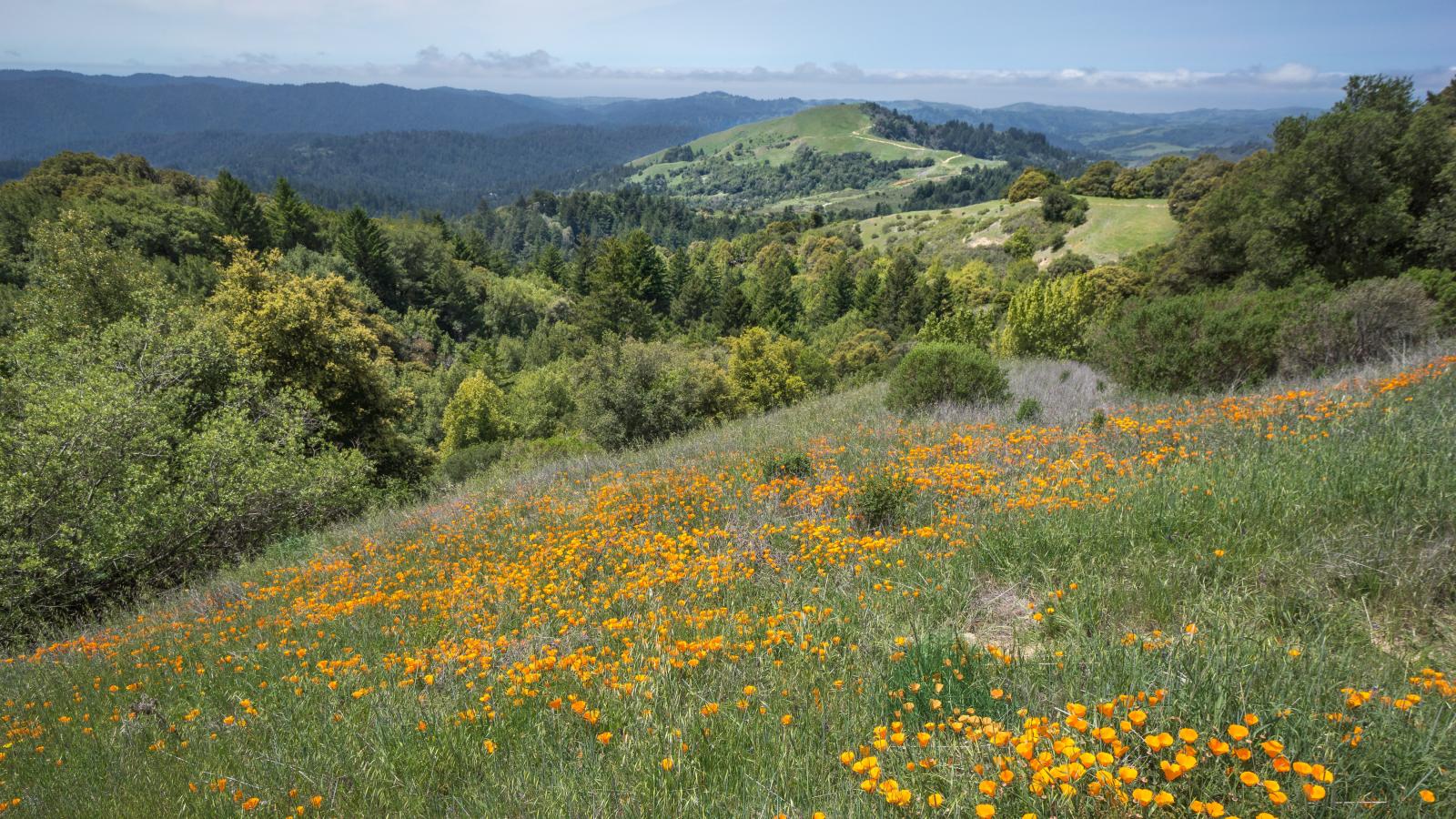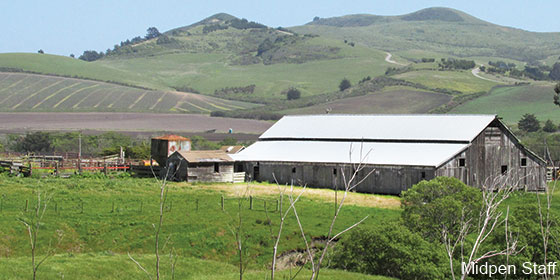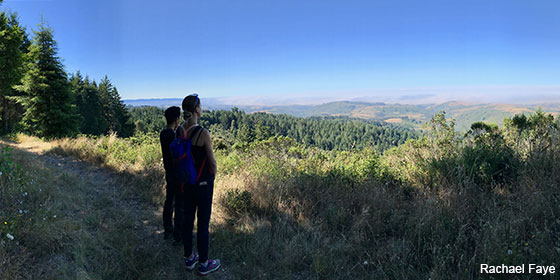This summer we bring you stories on new protected lands, wildlife research, building bridges to nature and more!
There are three ways to enjoy the quarterly newsletter: flip through the online version, scroll below to read, or download a pdf.
Wildland Fire Work Continues
Wildland fire does not pause for pandemics. This is why throughout the recent shelter-at-home orders, Midpen staff have continued developing our proposed Wildland Fire Resiliency Program and performing essential vegetation management for fire safety in the preserves.
The Wildland Fire Resiliency Program will proactively expand Midpen’s environmentally sensitive vegetation management to promote healthy, fire-adapted ecosystems, reduce wildland fire risk and facilitate fire suppression. This spring, we held public meetings online and began the required environmental review process so that we can expand our vegetation management and fuel treatment work in early 2021.
In the meantime, our rangers and maintenance staff, who are trained as fire first responders, remain busy working to prevent and prepare for wildland fire. They maintain hundreds of miles of priority fuel breaks, fire roads and emergency evacuation routes. Rangers also carry water pumpers on their trucks during fire season and continue year-round enforcement of banned fire-risk activities in the preserves, including smoking and campfires.
Learn more about how Midpen reduces wildland fire severity and risk by managing vegetation in the preserves with a focus on ecological health, and participate in developing our new Wildland Fire Resiliency Program at openspace.org/fire.
A Message from the General Manager
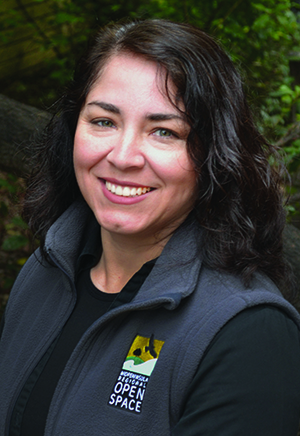 When We Need it Most, Nature Helps Us Heal
When We Need it Most, Nature Helps Us Heal
We know that nature helps us heal. And that in times of stress, people need a healthy outlet to decompress and a place to find solace and a new perspective to keep moving forward. A walk outside can remind us that nothing is static, like the hillsides that turn an emerald green each year with the winter rains, bringing us a sense of hope that things do change. The most difficult times of our lives will come and go and be replaced with some of the best times.
Midpen’s ability to provide a bit of welcome relief for residents who are sheltering at home and sacrificing for the greater good weighed heavy in our decision to try and keep public open space preserves open as long as possible. Many in our communities lack access to a backyard or struggle to find options to be outdoors in a green space that connects them to the sun’s warm rays, the sound of birds chirping, the sight of leaves moving with a breeze and the sweet smells of new blooms. For families with children, finding a place to roam outdoors is even more pressing. In this time of great public need we’re doing our best to be here to answer the call.
Residents have overwhelmingly responded with gratitude and appreciation. Most visitors follow new rules for social distancing, parking restrictions and one-way trails. A silver lining has been that as other avenues for spending free time shut down more people are discovering the wonders of exploring our public backyard oasis, many for the first time.
Our rangers and maintenance staff did a remarkable job keeping up with changing circumstances, implementing new measures to further promote social distancing and educating our visitors. Administrative staff maintained strong collaborations working remotely using multiple telecommuting and virtual meeting tools to continue Midpen’s work, including holding public meetings, finalizing the budget, moving projects forward and issuing this summer newsletter.
Although it is difficult to predict all the ways this unprecedented disruption will change our lives, something that we all have the opportunity to do is reflect on the interdependence that this crisis has highlighted; an interdependence to each other as members of a worldwide community and an interdependence to the land that we protect and which in turn sustains our mental, emotional, and physical health.

Ana María Ruiz
General Manager
Tunitas Creek Preserve Expands to Protect Wildlife, Watersheds and Agriculture
The relatively undeveloped San Mateo County Coastside represents one of the best ways Midpen can significantly protect remaining open space lands forever. Coastal grasslands are one of California’s most biodiverse ecosystems, and preserving this habitat provides room to protect and support our native plants and wildlife. Rare fish breed in coastal streams that begin at the ridgeline and collect precious fresh water across vast watersheds on their way to the ocean.
The Coast is still largely rural with a rich agricultural heritage that Midpen’s coastal mission pledges to sustain. Our community-supported Vision Plan identified viable working lands as a top priority. Tunitas Creek Open Space Preserve, located along Highway 1 south of Half Moon Bay and north of Highway 84 near San Gregorio, is an excellent example of how working lands contribute to the conservation goals of watershed and grassland habitat protection.
In April, the Midpen board of directors took advantage of an opportunity to significantly expand Tunitas Creek Preserve by approving the purchase of more than 540 additional acres from our nonprofit partner, Peninsula Open Space Trust. The property, known as Gordon Ridge, will bring the preserve to just over 2,200 contiguous acres hosting an abundance of native plants and wildlife, as well as local agriculture.
The purchase is expected to finalize in June for a total of $9.165 million, offset by a $1.96 million grant from the California Natural Resources Agency.
“I’m very excited about Gordon Ridge,” Midpen Rangeland Ecologist Lewis Reed said. “It has healthy stands of native coastal grassland plant communities. I’ve seen signs of recent badger activity there, as well as savannah sparrows and Say’s phoebes; all unique grassland species.”
San Gregorio Creek winds along the property’s southern border, providing some of San Mateo County’s last-known spawning grounds for endangered coho salmon and threatened steelhead trout. Midpen has completed several creek restoration projects upstream in the watershed to help these fish survive, and this purchase will provide opportunities to build on that work.
Much of Gordon Ridge has been continuously grazed with cattle for more than a century and the property includes a dairy barn built around 1870. Currently, fifth-generation Coastside rancher Tom Pacheco grazes cattle at Gordon Ridge with the help of his daughter, Rachel Pacheco Catuzia. They will continue this work as part of Midpen’s conservation grazing program. Midpen partners with small-scale local ranchers to utilize conservation grazing as a critical tool for responsibly managing approximately 8,000 acres of coastal grasslands for ecological health, biodiversity and wildland fire safety.
Coastal grasslands benefit from periodic disturbance, historically provided by grazing wildlife herds and Native American burning practices, to prevent loss of biodiversity from nonnative vegetation and encroaching shrubs and forest.
“I am looking forward to working with Tom Pacheco on stewarding this landscape. I have worked on and visited other sites that are part of his grazing operations, and he has been a good steward of sensitive resources,” Reed said. “Our goal is to use conservation grazing as a tool to maintain and enhance native grasslands and their use by diverse wildlife.”
Gordon Ridge also includes just under an acre leased to Blue House Farm as part of an adjacent 60-acre certified organic farm growing vegetables, fruits and cut flowers. Their products are sold at local farmers’ markets and farm stands, and through wholesale accounts.
Tunitas Creek Preserve currently has no public access due to its isolation and lack of infrastructure, however, this purchase will make future access opportunities more feasible. In fact, the Ohlone-Portola Heritage Trail, currently being planned by a regional committee of public land managers, may one day pass through this preserve.
In the meantime, Midpen is preparing to preserve this magnificent coastal landscape as public open space to protect its coastal grasslands, watersheds, wildlife and local agricultural heritage for generations to come.
Have you visited a preserve lately?
We've seen a lot more people enjoying nature out in the preserves in the past few months. We'd like to hear about your experience and find out a little bit about you! Take our short online survey and you can be entered into a drawing to win some cool Midpen gear!
Studying the Secret Life of Badgers and Burrowing Owls
After local wildlife camera footage of a badger and coyote went viral recently, many residents were surprised to learn that American badgers are native to the Bay Area, including on Midpen lands. These secretive masked animals with a feisty reputation are nocturnal and sleep underground, making them seldom seen or studied.
Midpen is conducting groundbreaking new research on local badgers, and the burrowing owls that often use badger dens as shelter. This work is being conducted with the help of wildlife cameras, trained volunteers, and our partners Pathways for Wildlife and the San Francisco Bay Bird Observatory. Badgers and burrowing owls both depend on grasslands and are species of special concern in California, having lost much of their habitat to development and encroachment from brush, forest and invasive plants.
We are conducting the largest-known study on Midpen lands to determine how many badgers and burrowing owls live in the preserves and how they’re using the landscape. First, we modeled suitable grasslands and corridors likely to be used by badgers. Then, we surveyed those areas for evidence of badgers and burrowing owls using wildlife cameras and onsite observations over the course of a year.
We’re beginning to see surprising results. Badgers have been detected at 17 different sites and are using several corridors to move between Midpen preserves.
Using hair and scat samples, we’re also studying whether the local badger population is healthy and genetically diverse, or at risk of inbreeding. We have detected one burrowing owl and are curious whether year-round populations breed successfully or if they only overwinter in Midpen preserves.
More data is needed and our surveys will continue for at least another year. We’ll keep you updated on the results, which will help Midpen and our partners make science-based decisions about how to best manage the grasslands in our care so that these amazing animals can survive and thrive.
Learn more and watch a video of badgers and a burrowing owl from this study.
American badger
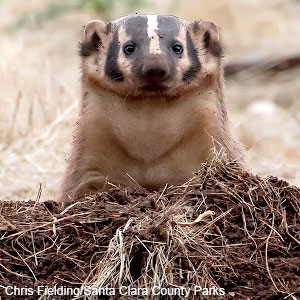 Ranging from Canada to Mexico, badgers are declining due to habitat loss.
Ranging from Canada to Mexico, badgers are declining due to habitat loss.
Badgers need grassland home ranges of 1,000+ acres to hunt burrowing rodents, insects and ground birds. They shelter in dens during the day, and sometimes hunt in mutually beneficial partnerships with coyotes.
Their flat bodies, short legs and long claws are built for digging. Thick, loose skin, strong jaws and ability to emit a musky odor provide their defense.
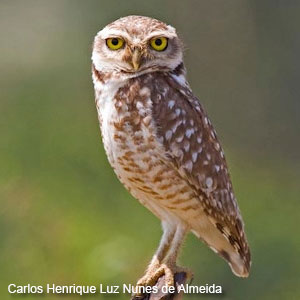 Burrowing owl
Burrowing owl
Burrowing owls are active during the day and spend most of their time on or near the ground. Found in Canadian prairies and the western United States, they require grasslands to hunt insects and small animals. California’s burrowing owls are in steep decline due to habitat loss.
Smaller than a crow and mottled brown with long legs and yellow eyes, they use the ground burrows of other animals to shelter and nest in.
Outdoor Activities
At this time our summer docent-led interpretive activities remain on hold. We anticipate the requirement of special, public health-based measures to be implemented on docent-led activities that could include limitations on group size, adherence to distancing practices, and possibly the wearing of masks. Additionally, all summer docent-led activities will likely require reservations. Final determinations on activity modifications have not been established.
The Midpen Docent Naturalists miss being out on the trails with you all and look forward to soon being able to share nature discoveries together again. Stay well, stay strong, stay poised for a preserve visit and well-deserved summer outing.
Get the latest activity information
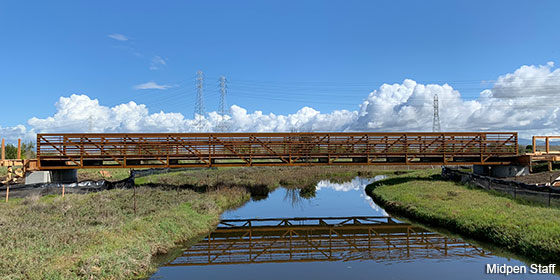
Building a Bridge to Nature
Before the pandemic, we were making great progress constructing a small-but-mighty new segment of the San Francisco Bay Trail in our Ravenswood Open Space Preserve near East Palo Alto. The 0.6-mile trail will close a critical gap connecting 80 continuous miles of the Bay Trail and will provide the surrounding community with a bridge to nature.
“The current health crisis has underscored how essential Midpen preserves are for providing free and safe public access to nature for mental, emotional and physical health,” Midpen General Manager Ana María Ruiz said. “This small trail will provide big benefits to the community.”
A new sidewalk along University Avenue will connect with the new trail and its bayland views, educational signs and a raised boardwalk and bridge across salt marsh wetlands.
The project also includes wetlands restoration, including refugia islands providing critical habitat for endangered wildlife, such as salt marsh harvest mice and Ridgeway’s rails, to retreat to as climate change causes sea level rise.
While construction was temporarily slowed by the recent shelter-in-place orders, we are hoping to finish the project and open it to the public later this year if circumstances allow. Stay tuned!
Find out more about Ravenswood Preserve
Envisioning a Bay to Sea Trail
The Bay to Sea Trail is envisioned as an approximately 40-mile multiuse trail that will connect people from across the peninsula to open space and create a link between the San Francisco Bay Trail and the California Coastal Trail along the Pacific Ocean. Midpen joined 10 other agencies and organizations to collaborate on creating the Bay to Sea Trail for public use by 2037.
Learn more about the Bay to Sea Trail
Serve on the Midpen Bond Oversight Committee
Midpen seeks individuals who are committed to transparency, accountability to serve on the Bond Oversight Committee, and provide oversight for all Measure AA funds collected and expended. Members of the committee are required to be residents living in Midpen’s jurisdiction. Application deadline is Friday, June 26 at 5 p.m.

